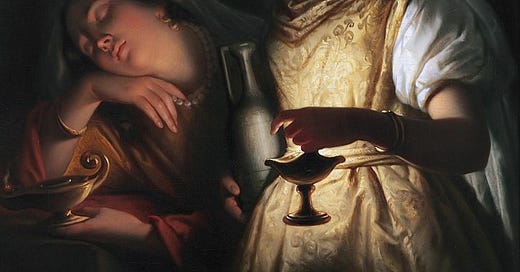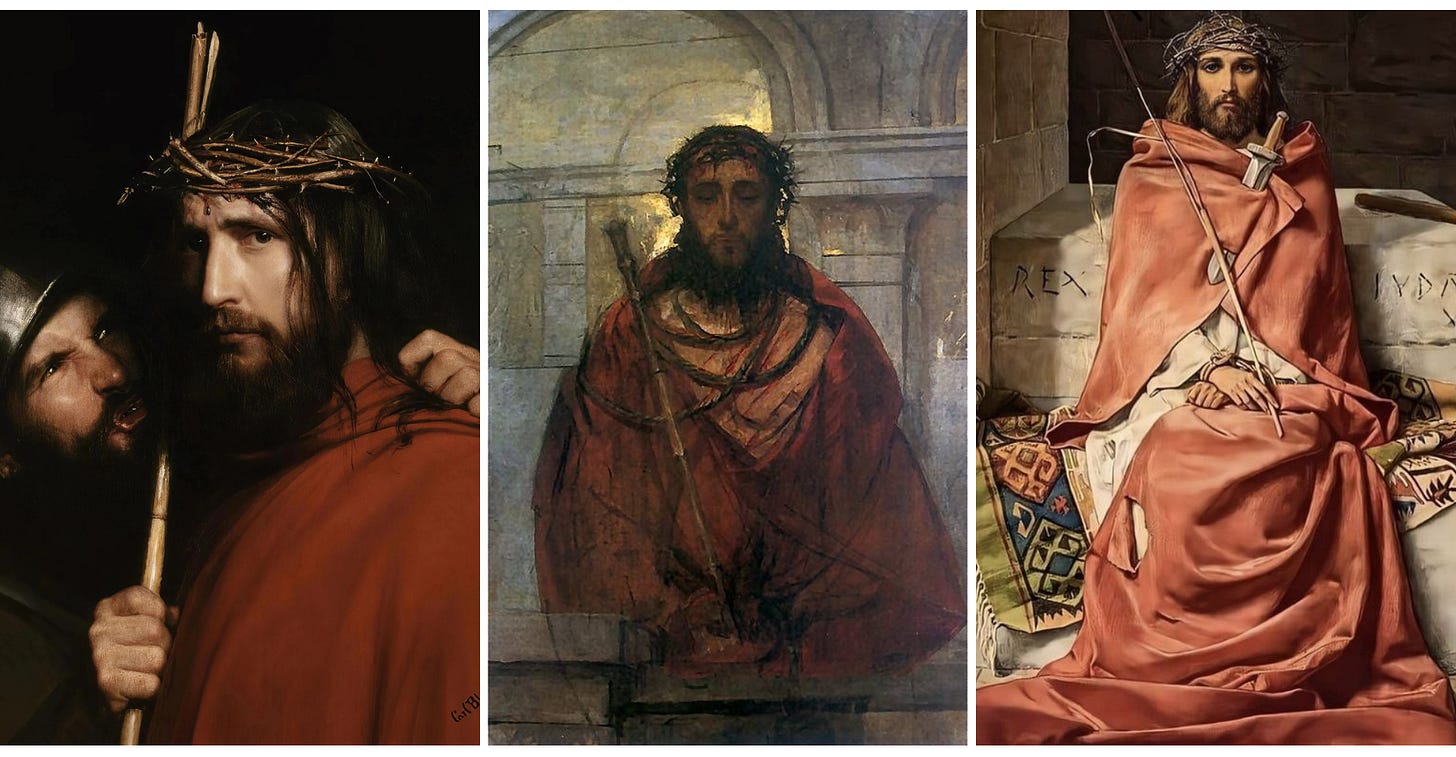Happy new (liturgical) year everyone!
We’ve officially entered the season of Advent, and you probably noticed several changes on Sunday—a different mood to the liturgy and the readings, different decorations in the church, perhaps, and of course different colored vestments.1 With this in mind, I wanted to make a post about this season’s liturgical color(s), the meaning behind them, and how the laity can use them to celebrate this season.

What are liturgical colors?
Before diving in, I’ll try to give a quick overview of what “liturgical colors” even are. In the earliest days of the Church, it seems that white was the universally accepted color for celebrating the Mass; this was the dominant standard from about the 4th century to the 9th. Other colors began to be slowly incorporated in different areas with no standardization in the next couple centuries. Pope Innocent III, writing in the 1190s before he became pope, listed four principal liturgical colors: white, red, black, and green. Violet was considered a (less preferable) shade of black.2 This was not a prescription but rather a description of the organic developments of liturgical colors throughout the Church. By the 16th century, however, aware of the need for standardization, Pope Pius V promulgated a new Missal with 5 prescribed colors: white, red, green, violet, and black.3
The Church uses different colors in her different seasons to deepen our understanding and observance of these times. In The Holy Sacrifice of the Mass (1902), Fr. Nikolaus Gihr writes:
As in the Old, so also in the New Law there are different liturgical colors which impart to the vestments not only splendor, beauty, and variety but also a religious symbolical meaning. The rich, deep symbolism of the colors was the determining reason why the Church selected and prescribed various colors for the different feasts and seasons, as well as for special functions of the holy year.
Each color expresses some truth about the day or season in which it is worn; for instance, on the feast of any martyr, you will see the priest wearing red, which has a dual meaning: blood and royalty. Red vestments remind us that the saint we are commemorating died for Christ and has now received a heavenly reward.
Not only the clergy but also the altar and the sacred vessels should match the liturgical color of the day or season. For the clergy, this includes the maniple, stole, chasuble, dalmatic, and cope. The cincture may or may not match. For the altar, the antependium (altar frontal) and conopaeum (tabernacle veil—though a white veil may be used all-year “in poor churches”). For the vessels, the chalice veil and burse.
The laity in attendance at Mass or another celebration (like a procession) are in no way required to match the liturgical color! If you do not own a nice violet dress, you don’t need to rush out and buy one. However, I’ve found that when I take the time to think about the day’s liturgical color and try to match it, it really deepens my experience of that feast. One of my favorite ways to do this is by tying a liturgically-appropriate ribbon to my purse—so last Monday on the feast of St. Catherine of Alexandria I had a red ribbon. For the rest of the day, when I saw the ribbon, I was reminded of St. Catherine, and by the time I went to Mass that evening, I felt much more prepared to celebrate her.
What is the color for Advent?
For a time, black was considered the best color for Advent (and also Lent, the other penitential season of the year). However, violet is now the standard color of this season, with some variation on Gaudete Sunday:
Black is a negation of color and peculiarly expressive of sadness. […] It is for this reason that down to the thirteenth century it was used during seasons of affliction and penance. But since sin, the only true misfortune in the spiritual life, does not absolutely exclude the light of grace, violet took the place of black, which was retained in the liturgy only on Good Friday and in the service of the dead.4
Various shades of violet or purple can be seen at different churches, some closer to indigo and some to burgundy. As it is used for penitential seasons, a pastel or light violet isn’t really appropriate… except for when it is. The third Sunday of Advent is known as Gaudete Sunday after the incipit of the introit (Gaudete in Domino semper…), and on this Sunday the vestments should be coloris rosacei (of rose color). Gihr describes this rose color as a “lighter violet, which is so close to the red;” the Ecclesiastical Review, too, calls it “violet of a lighter hue.” The rose of Gaudete Sunday is not supposed to be bright bubblegum pink, but a color bordering on red. You can read more about rose and see good examples here.
What do violet and rose symbolize in Advent?
Let me start with something that violet does not symbolize. There’s a common belief that purple (or violet) is the color of royalty. In the west, this comes from the ancient “Tyrian purple,” a ridiculously expensive dye associated with Roman emperors. However, Tyrian purple was more of a crimson color; the most desirable shade of Tyrian purple was described as dried or clotted blood (not exactly a majestic image, but okay). You can see an example of it in this mosaic of Emperor Justinian:
This is also the color in which Our Lord was clothed during His passion, although it is often translated as purple.5 In the majority of paintings of the crowning with thorns, His robe is this dried-blood red:
We can also think of the Apostles being “crowned” with tongues of fire on Pentecost, of Christ now enthroned in glory with His red wounds, of saints in Heaven washing their robes in the red blood of the Lamb. So red is for royalty—what does violet symbolize, then?
Violet is associated with humility, temperance, and penance. Gihr gives this (literally) flowery explanation of the symbolism of violet:
In so far as the violet-color is like the dark coloring of the violet, which modestly conceals itself amid the grass of the field, in the vale and wood from human eye, blooming and yielding its perfume but for its Creator, it may be considered as an emblem of unpretentious humility, of holy retirement, of well-tempered sorrow, of a sorrowful longing and sighing after Heaven. The dark, serious violet, therefore, bespeaks sadness; though not a complete and universal sadness, but one that is moderated and tempered with rays of joy.
In Advent, we are penitential; we meditate on the brokenness and darkness of our world and our hearts; we endeavor to cleanse ourselves and make space for the coming Lord. Although we often spend this season rushing around and celebrating Christmas, Advent is actually a time of “longing and sighing after Heaven” and waiting in hope and expectation. Violet combines the blue of sorrow with the red of fervor and hope; we are mourning, but we are also looking ahead to the promise of the greatest consolation. During Advent, we are reminded of Christ’s words: “Those whom I love, I reprove and chasten, so be zealous and repent! Behold, I stand at the door and knock; if anyone hears My voice and opens the door, I will come in to him and eat with him and he with Me.”6
We can think of rose as violet with more “rays of joy.” It is lighter, less somber, more fitting for a joyful occasion. On Gaudete Sunday, in the midst of sorrow and waiting, we have a sudden reminder that the coming of our Lord is at hand and growing closer every day; what better reason to rejoice? Dom Gueranger writes of Gaudete Sunday:
Today, again, the Church is full of joy, and the joy is greater than it was. It is true that her Lord has not come; but she feels that He is nearer than before, and therefore she thinks it just to lessen somewhat the austerity of this penitential season by the innocent cheerfulness of her sacred rites.
Rose-colored vestments tend to be more ornate than their violet counterparts, often with more trimming, more embroidery (florals, unsurprisingly, are a common motif), to express the greater joy of this day. The return of violet on the next Sunday is a good display of the moderation of the season, in my opinion—it’s like our red joy has been re-tempered with a dose of dark blue contrition. He is almost here! rejoice! but do not let your oil burn out, keep your wick trimmed, for we do not know when the Bridegroom comes.7
Our priest just broke out a beautiful new green cope on the last Sunday after Pentecost, which was at first exciting to me (because I’m a nerd) then a little disappointing when I realized that we would not get to see it again for a month or so.
De sacro altaris mysterio.
This prescription also excluded certain colors and combinations. Even in the new missal promulgated by Pope Paul VI, certain colors are excluded.
For instance, I was taught in high school that blue is an official liturgical color for Marian feasts—it’s not. A select number of dioceses are allowed to wear sky-blue vestments in recognition of their historical defense of Marian dogmas, but this is a specific privilege (Apostolic Indult) given to them only. For those outside of this privilege, predominantly white vestments with blue ornamentation is the acceptable way to dress for a Marian feast.
“Sacred Vestments,” The Ecclesiastical Review vol. 31, 1904.
Mark 15:17
Revelation 3:19-20
Matthew 25:1-13. We should keep in mind that while we are celebrating the particular season of Advent right now, our lives are actually one long Advent as we wait to meet Him (one way or the other). The Scriptures instruct us to be sober and vigilant—not just in the days leading up to Christmas, but at all times.







